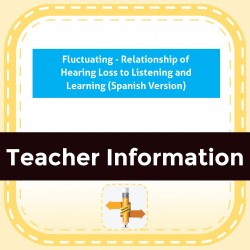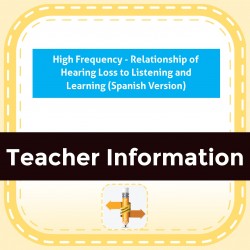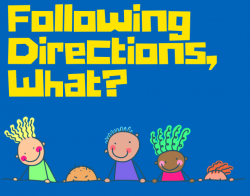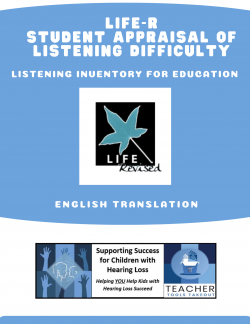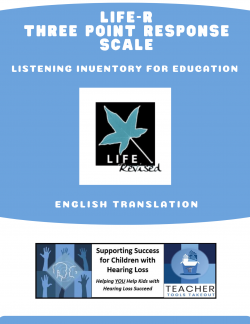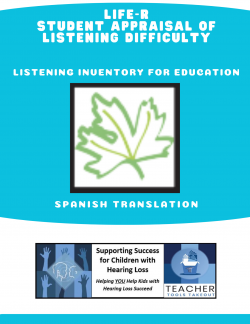Ability Levels
Categories
Resource Types
Age/Grade Range
CCSS
Anchor Standard
Speaking & Listening
Language
Reading
Fluctuating - Relationship of Hearing Loss to Listening and Learning (Spanish Version)
$ 0
Handout with information on possible impact on understanding language, speech, social, and need for educational accommodations and services in Spanish language. For 16-25dB or minimal hearing loss.
...
High Frequency - Relationship of Hearing Loss to Listening and Learning (Spanish Version)
$ 0
Handout with information on possible impact on understanding language, speECH-, social, and need for educational accommodations and services in Spanish language. For high-frequency hearing loss.
...
Following Directions
$ 3
LIttle ones don't always listen and follow directions. Here is a simple social story to encourage conversation and help them see the importance of following directions in school.
CAVE Checklist - Communication Access in Virtual Education (Fillable)
$ 2
The CAVE Checklist (Fillable Version) is a self-report checklist is intended to be completed students age 9 and above who are deaf or hard of hearing to identify possible communication access issues t
...
hat may occur during virtual education situations. It is recommended that the CAVE be completed in an interview format with the DHH specialist discussing each situation with the student. Students read 10 questions related to accessing communication in online learning situations and rate them from Always Easy to Always Difficult, or Doesn't Happen. A total score can be obtained. Not every situation will apply to every student. Situations indicating appropriate access will receive scores of 4 or 5. Items scoring 1, 2, 3, need to be addressed for appropriate access needs. The 10 questions are followed by a list in which the student identifies what he or she thinks helps most during online learning.
LIFE-R Student Appraisal of Listening Difficulty
$ 0
Listening Inventory For Education - Revised 15 questions in the Student Appraisal. 5-level response rating level of challenge listening under 15 different classroom and school listening situations.
Three Point Response Scale for LIFE-R or Other Listening Tasks
$ 0
Easy-Medium-Hard response choice with face images reflecting level of challenge. Can be used with LIFE-R checklist or when discussing level of listening challenge with language-limited children.
ITOD - TOD Service Hall Pass: Fillable
$ 3
printabledigitally fillableAre you an itinerant on the run? Are you tired of waiting in the front office for someone to write a pass for your student? Have you had a school(s) ask you to bring your p
...
pass? In the last couple of years, some districts asked all specialists to bring their own prefilled passes, even though we are contracted specialists.Now, when I enter middle and high school, I get looks of relief and often express gratitude for being efficient and professional. **This works best with schools where your identity is already established with front office staff.For those Teachers of the Deaf who do not travel but like pretty teaching things, this might be for you too. This new product costs only $2.00 for a set of 9 designs in fillable or printable options. Plus a page with space to upload your school/agency logo or letterhead.
Self-Advocacy Scenarios: "Ideal" vs. "Difficult" Listening Scenarios (End of the Year and Summer-Themed)
$ 375
This self-advocacy product contains 15 possible scenarios that students could face as a learner who is deaf/hard-of-hearing. The scenarios are end of the year and summer-themed situations. Read each s
...
scenario with your students. Have your students decide if it is an "ideal" listening situation or a "difficult" listening situation.
LIFE-R Student Appraisal of Listening Difficulty - Spanish Translation
$ 0
Spanish translation - Listening Inventory For Education - Revised 15 questions in the Student Appraisal. 5-level response rating level of challenge listening under 15 different classroom and school li
...
stening situations.
Before LIFE Questions for Students
$ 0
Part of the Listening Inventory For Education Suite of Checklists. Student selects multiple choice answers to identify classroom seat location, external sounds, knowledge of how well he can hear the t
...
eacher, feelings about listening devices. Good to use as a 'get set' activity before administering the LIFE-R Student Appraisal and After LIFE-R.
 Your browser is out of date. For best experience switch to latest updated Browser.
Your browser is out of date. For best experience switch to latest updated Browser.
 Get Chrome
Get Chrome Get Edge
Get Edge Get Firefox
Get Firefox